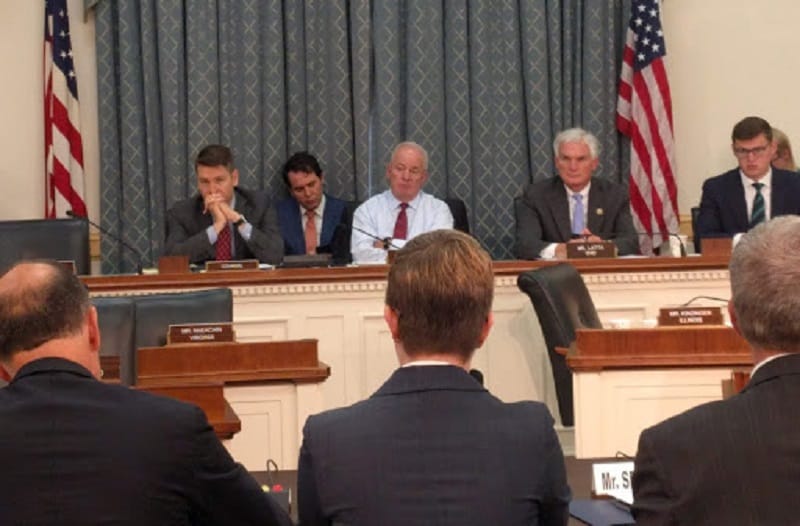With FCC Broadband Maps Denounced as ‘Terrible,’ Members of Congress Drill Into Details For Improvement

WASHINGTON, September 11, 2019 – Given the widespread support for more accurate maps of broadband availability in Congress, lawmakers and telecom experts said Wednesday that the Federal Communication Commission’s mapping structure and reporting mechanism have room for improvement.
“It is not an exaggeration to say this FCC’s terrible broadband data is its Achilles heel,” said House Committee on Energy and Commerce Chairman Frank Pallone, D-N.J., in the opening remarks of Wednesday’s hearing.
He cited information from the advocacy group Free Press to demonstrate that one carrier alone was overstating its deployment by 2.2 million consumers, throwing off the FCC’s entire estimate of unserved Americans.
Republicans largely agreed. Rep. Greg Walden, R-Ore., said that Congress must ensure that the FCC and the Universal Service Program are relying on sufficiently accurate and granular information.
“Granular” and “shape-file mapping” were the buzzwords echoed by the hearing’s witnesses, indicating the urgent need to revamp the current mapping system.
Shape files are a good step forward, said Shirley Bloomfield, Chief Executive Officer of the NCTA – The Rural Broadband Association.
However, she added, granularity is not the same as accuracy. A uniform standard for reporting is necessary to provide more efficient broadband.
Under FCC’s form 447, said James Assey, Executive Vice President of NCTA – The Internet & Television Association, broadband coverage must be reported on a census block level. This is flawed methodology that inaccurately depicts underserved areas.
Polygon-shaped files can better detect unserviceable areas within unserved areas, he said.
The divide extends far beyond unserved communities, said Dana Floberg, policy manager at Free Press Action. Only 22 percent of households with average incomes below $20,000 can subscribe to wired broadband services.
That is why Free Press Action supports the Broadband Data Improvement Act and the Mapping Accuracy Promotion Services Act for more granular coverage, she said.
US Telecom CEO Jonathan Spalter, touted his association’s broadband mapping pilot project, which he said demonstrated that the nation has the skills and ability to quickly and affordably map the gap.
FCC standards are inconsistent with the metrics broadband companies use to analyze service, said Grant Spellmeyer, vice president of federal affairs and public policy at U.S. Cellular. It will take more than $25 billion to achieve universal broadband service.
Serviceable location fabric helps determine where broadband is and where it isn’t, said James Stegeman, president and CEO of CostQuest Associates, which participated in US Telecom’s pilot project. The quality of location serviceable data will be improved regardless of the method that the FCC decides to employ, he said.
Members of Congress speaking at the hearing were concerned about the logistics of developing improved mapping.
Rep. Robert Latta, R-Ohio, inquired about the time length needed to develop a comprehensive broadband mapping program.
According to Spalter, it could take 11 to 15 months to develop the groundwork for a more granular approach.
It’s also important for the public to participate in the process and understand how these maps work, said Spellmeyer.
Rep. Jerry McNerney, D-Calif., asked how a crowdsourcing process can improve broadband mapping.
Consumers on the ground would be able to give feedback on the coverage they’re getting, Bloomfield said. However, they need to first understand how fast their internet speed is.
The proprietary route of collecting data on underserved areas would be quicker and cost less money, said Stegeman. The alternative to that is an open-source data set, which would require a digital verification process.
Billions of dollars have been spent so far by the government and the public, said Rep. Adam Kinzinger, R-Ill., yet we still have an inadequate broadband supply.
Affordability is critical, said Rep. David Loebsack, D-Iowa. This isn’t a rural or urban issue; this is on the national level.
The America people are getting frustrated, said Rep. Bill Johnson, R-Ohio. It’s not that tough, he said, to figure out who has broadband and who doesn’t.
This initiative is about mapping America’s future, said Rep. Anna Eshoo, D-Calif. She said that the country needed to ask itself if this legislation can meet future challenges.
Also weighing in was the Wireless Internet Service Providers Association. “For far too long, policymakers have had only opaque information derived from inaccurate maps to guide where subsidies for broadband should be allocated,” said WISPA Vice President of Government Affairs Christina Mason, in a statement.










Member discussion